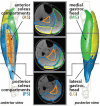Achilles Tendon Morphology Is Related to Triceps Surae Muscle Size and Peak Plantarflexion Torques During Walking in Young but Not Older Adults
- PMID: 33345079
- PMCID: PMC7739823
- DOI: 10.3389/fspor.2020.00088
Achilles Tendon Morphology Is Related to Triceps Surae Muscle Size and Peak Plantarflexion Torques During Walking in Young but Not Older Adults
Abstract
The interaction of the triceps surae muscles and the Achilles tendon is critical in producing the ankle plantarflexion torque required for human walking. Deficits in plantarflexor output are a hallmark of reduced mobility in older adults and are likely associated with changes in the triceps surae muscles that occur with age. Structural differences between young and older adults have been observed in the Achilles tendon and in the triceps surae muscles. However, less is known about how age-related differences in muscle and tendon morphology correspond with each other and, furthermore, how those morphology differences correlate with age-related deficits in function. The goal of this work was to investigate whether there is a correlation between age-related differences in triceps surae muscle size and Achilles tendon cross-sectional area (CSA) and whether either is predictive of ankle plantarflexion torque during walking. We used magnetic resonance imaging (MRI) to measure triceps surae muscle volumes and tendon CSAs in young (n = 14, age: 26 ± 4 years) and older (n = 7, age: 66 ± 5 years) adults, and we determined peak plantarflexion torques during treadmill walking. We found that individual muscle volumes as a percentage of the total triceps surae volume did not differ between young and older adults, though muscle volumes per body size (normalized by the product of height and mass) were smaller in older adults. Achilles tendon CSA was correlated with body size and muscle volumes in young adults but not in older adults. The ratio of tendon CSA to total triceps surae muscle volume was significantly greater in older adults. Peak ankle plantarflexion torque during walking correlated with body size and triceps surae volume in young and older adults but was correlated with tendon CSA only in the young adults. Structure-function relationships that seem to exist between the Achilles tendon and the triceps surae muscles in young adults are no longer evident in all older adults. Understanding mechanisms that determine altered Achilles tendon CSA in older adults may provide insight into age-related changes in function.
Keywords: aging gait; gastrocnemius; muscle volume; plantarflexion torque; soleus; tendon cross-sectional area.
Copyright © 2020 Knaus, Ebrahimi, Martin, Loegering, Thelen and Blemker.
Figures






Similar articles
-
Older Adults Overcome Reduced Triceps Surae Structural Stiffness to Preserve Ankle Joint Quasi-Stiffness During Walking.J Appl Biomech. 2020 Jun 5;36(4):209-216. doi: 10.1123/jab.2019-0340. Print 2020 Aug 1. J Appl Biomech. 2020. PMID: 32502975 Free PMC article.
-
Triceps surae muscle-subtendon interaction differs between young and older adults.Connect Tissue Res. 2020 Jan;61(1):104-113. doi: 10.1080/03008207.2019.1612384. Epub 2019 May 22. Connect Tissue Res. 2020. PMID: 31116576 Free PMC article. Clinical Trial.
-
Aging effects on the Achilles tendon moment arm during walking.J Biomech. 2018 Aug 22;77:34-39. doi: 10.1016/j.jbiomech.2018.06.001. Epub 2018 Jun 18. J Biomech. 2018. PMID: 29945784 Free PMC article.
-
Imaging and simulation of Achilles tendon dynamics: Implications for walking performance in the elderly.J Biomech. 2016 Jun 14;49(9):1403-1410. doi: 10.1016/j.jbiomech.2016.04.032. Epub 2016 May 3. J Biomech. 2016. PMID: 27209552 Free PMC article. Review.
-
Typical m. triceps surae morphology and architecture measurement from 0 to 18 years: A narrative review.J Anat. 2022 Apr;240(4):746-760. doi: 10.1111/joa.13584. Epub 2021 Nov 8. J Anat. 2022. PMID: 34750816 Free PMC article. Review.
Cited by
-
Using muscle-tendon load limits to assess unphysiological musculoskeletal model deformation and Hill-type muscle parameter choice.PLoS One. 2024 Nov 14;19(11):e0302949. doi: 10.1371/journal.pone.0302949. eCollection 2024. PLoS One. 2024. PMID: 39541322 Free PMC article.
-
Age-related changes to triceps surae muscle-subtendon interaction dynamics during walking.Sci Rep. 2021 Oct 28;11(1):21264. doi: 10.1038/s41598-021-00451-y. Sci Rep. 2021. PMID: 34711893 Free PMC article.
-
Implications of variability in triceps surae muscle volumes on peak lower limb muscle forces during human walking.PLoS One. 2025 Mar 28;20(3):e0320516. doi: 10.1371/journal.pone.0320516. eCollection 2025. PLoS One. 2025. PMID: 40153384 Free PMC article.
-
No sex differences in evoked contractile properties after fatiguing isometric and isotonic exercise for the plantar flexors.J Musculoskelet Neuronal Interact. 2022 Dec 1;22(4):504-513. J Musculoskelet Neuronal Interact. 2022. PMID: 36458388 Free PMC article.
-
3D characterization of the triple-bundle Achilles tendon from in vivo high-field MRI.J Orthop Res. 2023 Oct;41(10):2315-2321. doi: 10.1002/jor.25654. Epub 2023 Jul 10. J Orthop Res. 2023. PMID: 37366039 Free PMC article.
References
Grants and funding
LinkOut - more resources
Full Text Sources

